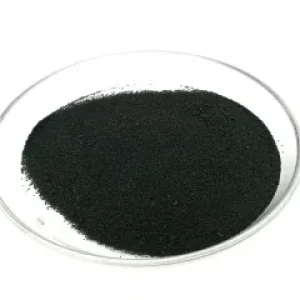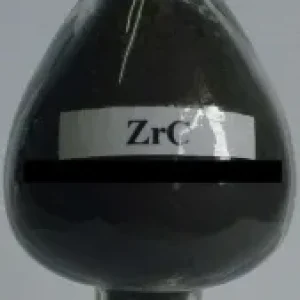Overview of Hafnium Carbide HfC Powder
Hafnium carbide HfC is a compound of carbon and hafnium. Hafnium carbide melting point is about 3900°C, one of the most refractory binary compounds known. However, its oxidation resistance is very low, and oxidation starts at temperatures as low as 430°C.
Hafnium carbide is a black, gray, brittle solid; high cross-section absorbs thermal neutrons; resistivity 8.8μohm·cm; the most refractory binary material known; hardness 2300kgf/mm2; used in nuclear reactor control rods. It is prepared by heating HfO2 with oil soot under H2 at 1900°C-2300°C. It is used as a crucible to melt oxide and other oxides.
An improved spark plasma sintering (SPS) device was used to synthesize ultrafine carbonized ha powder through the carbothermal reduction reaction of HfO2 at 1600°C. The synthetic powder has a fine particle size of about 125 nm and a low oxygen content of less than 0.5% by weight. Except for Zr, the powder purity is> 99.9%; when it contains Zr impurities, it is 99.6%. Due to the low synthesis temperature, rapid heating/cooling rate, and the current influence during the improved SPS process, intermediate reactions and particle growth are minimized. A new synthesis method can synthesize a relatively large amount of HfC powder (>175 g/day). After sintering the synthesized powder by SPS at 2300°C for 30 minutes under a pressure of 100 MPa, HfC ceramics with high relative density (>96%) were obtained.
Performance of Hafnium Carbide HfC Powder
Hafnium Carbide Powder, a gray metallic solid, has the highest melting point of a single compound and is a good material for the lining of high melting point metal smelting; it has a high melting point, high hardness, good high-temperature strength, and corrosion resistance. Excellent characteristics, such as better and lower thermal conductivity, can be used as an additive for cemented carbide, widely used in the field of cutting tools and molds; also suitable for rocket nozzle materials, can be used in the nose cone of rockets, often used in the aerospace field, It can also be used in nozzles, high-temperature linings, arcs or electrodes for electrolysis; it can also be used in nuclear reactor control rods.
Production Method of Hafnium Carbide HfC Powder produced
Hafnium carbide powder is prepared by reducing hafnium oxide with carbon at 1800 to 2000°C, in which a longer treatment time is required to remove all oxygen.
Hafnium carbide is a dark gray, brittle solid. It can be prepared by heating a mixture of elements or reacting hafnium tetrachloride with methane at 2100°C. A sufficient amount of hafnium oxide or metal sponge can be obtained in the large-scale production of pure zirconium for nuclear reactors. On an industrial scale, hafnium carbide can be made from hafnium hydride sponge at 1500–1700°C or from oxidized ha at 2000–2200°C by vacuum carburizing in the presence of hydrogen. The resulting carbide contains almost the theoretical amount of carbon (6.30%°C) and up to 0.1% free carbon (219). The obtained hafnium carbide is not a true stoichiometric compound but only a carbon solution at a specific interstitial position of the face-centered cubic lattice.
Carbonization is inert to most reagents at room temperature but will be dissolved by a hydrofluoric acid solution. Carbonization reacts exotherm with halogen at 250-500°C to form hafnium tetrahalide and hafnium oxide with oxygen above 500°C. In the presence of hydrogen, hafnium carbide will slowly lose some carbon at higher temperatures.
Application of Hafnium Carbide
Hafnium carbide (HfC) has the highest melting point of any known binary alloy and has many high-temperature applications. It is a candidate for extremely high-temperature applications, such as rocket nozzles and scramjet components. Carbonization can also be used in hard coatings, usually applied by processes such as plasma spraying. In addition, HfC structural foam can be made into high-temperature components or used as thermal insulation materials.
Hafnium carbide (HfC), whose melting point exceeds 3890°C, is a refractory binary compound. HfC and NBC can also be used as refractory coatings in nuclear reactors. The mixed carbide Ta4HfC5 has the highest melting point at 4215°C.
1. Hafnium carbide can be used as an additive for cemented carbide, widely used in the field of cutting tools and molds;
2. Hafnium carbide applicable to the rocket nozzle material, can be used in the nose cone of the rocket, applied in the aerospace field, and can also be applied to the nozzle, high-temperature lining, arc, or electrode for electrolysis;
3. Hafnium carbide is used in nuclear reactor control rods. It is an ideal metal for making nuclear reactor control rods;
4. Used to prepare ultra-high temperature ceramics;
5. Reactant for synthesizing hafnium-containing organometallic polymer;
6. For coating.
Storage Condition of Hafnium Carbide HfC Powder
Hafnium Carbide HfC Powder should be stored in dry, cool and sealing of the environment, can not be exposure to air, in addition should avoid the heavy pressure, according to ordinary goods transportation.
Company Profile
My Carbides is a trusted global chemical material supplier & manufacturer with over 12-year-experience in providing super high-quality carbides and relatives products.
The company has a professional technical department and Quality Supervision Department, a well-equipped laboratory, and equipped with advanced testing equipment and after-sales customer service center.
If you are looking for high-quality Carbides, please feel free to contact us or click on the needed products to send an inquiry.
Payment Methods of Hafnium Carbide HfC Powder
L/C, T/T, Western Union, Paypal, Credit Card etc.
Shipment of Hafnium Carbide HfC Powder
It could be shipped by sea, by air, or by reveal ASAP as soon as repayment receipt.
Package of Hafnium Carbide HfC Powder
Vacuum packing, 100g, 500g or 1kg/bag, 25kg/barrel, or as your request.
FAQ
Q1: What are the physical properties of hafnium carbide?
Answer: Hafnium carbide has physical properties such as high density and high melting point (about 3890°C). It usually appears as a gray solid with a metallic luster and is stable at room temperature.
Q2: What are the chemical properties of hafnium carbide?
Answer: Hafnium carbide shows good stability to most acids and bases at room temperature. But at high temperatures or under certain conditions, it may react with certain oxidants or water vapor.
Q3: What are the applications of hafnium carbide in ceramic materials?
Answer: As an excellent ceramic material, hafnium carbide can be used to prepare ceramics with high hardness and high melting point. These ceramic materials are widely used in aerospace, energy, electronics and other fields, such as engine nozzles, combustion chamber liners, electronic packaging, etc.
Q3: What is the supply and demand situation of hafnium carbide?
Answer: The supply and demand of hafnium carbide are affected by many factors, including raw material prices, production technology, policies and regulations, and market demand. With the continuous advancement of technology and the continuous expansion of the market, the supply and demand of hafnium carbide are expected to maintain steady growth.
Q4: How safe and environmentally friendly is hafnium carbide?
Answer: When handling hafnium carbide, you need to follow the corresponding safe operating procedures and wear appropriate protective equipment. At the same time, effective measures should be taken to prevent the release and spread of hafnium carbide dust to avoid harm to the human body and the environment. In terms of environmental protection, the production and use of hafnium carbide should comply with relevant environmental standards and regulations to reduce the impact on the environment.







